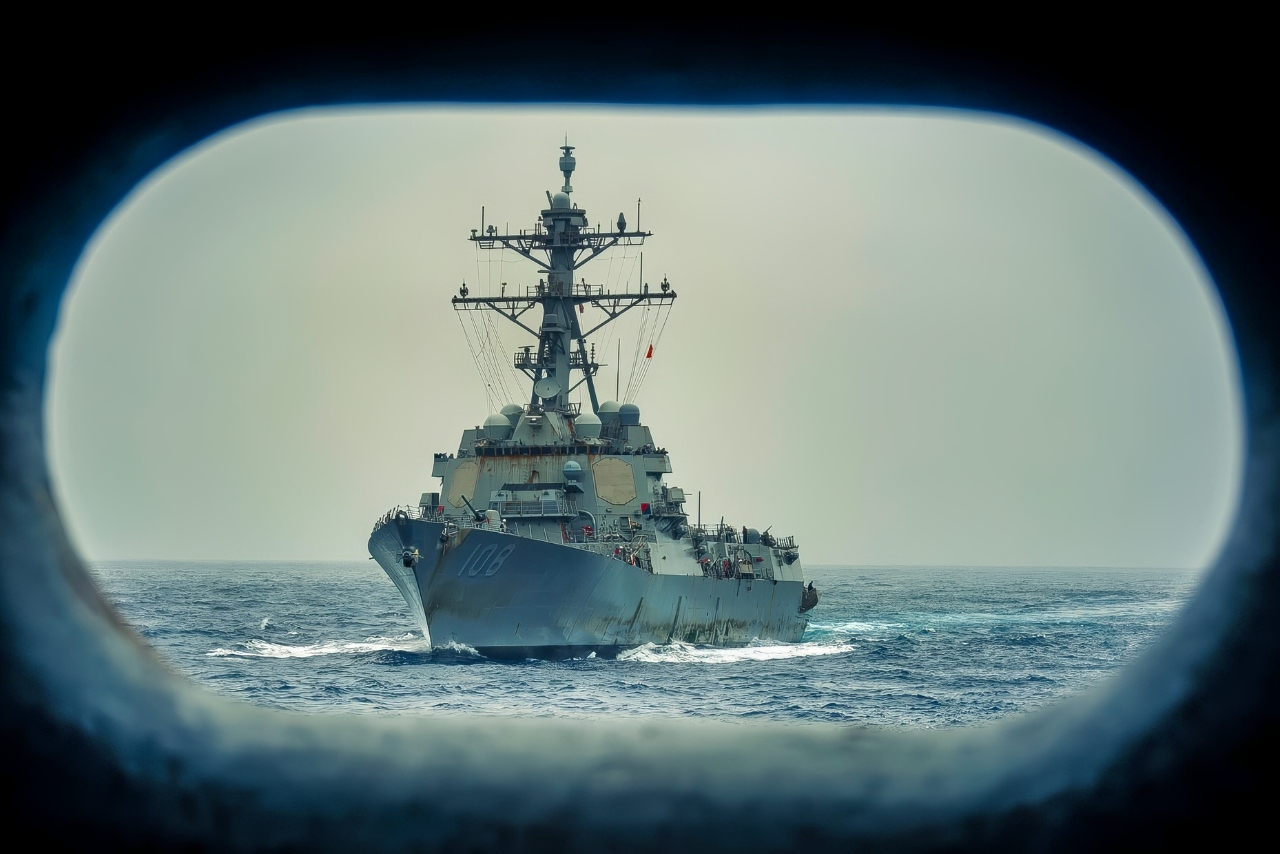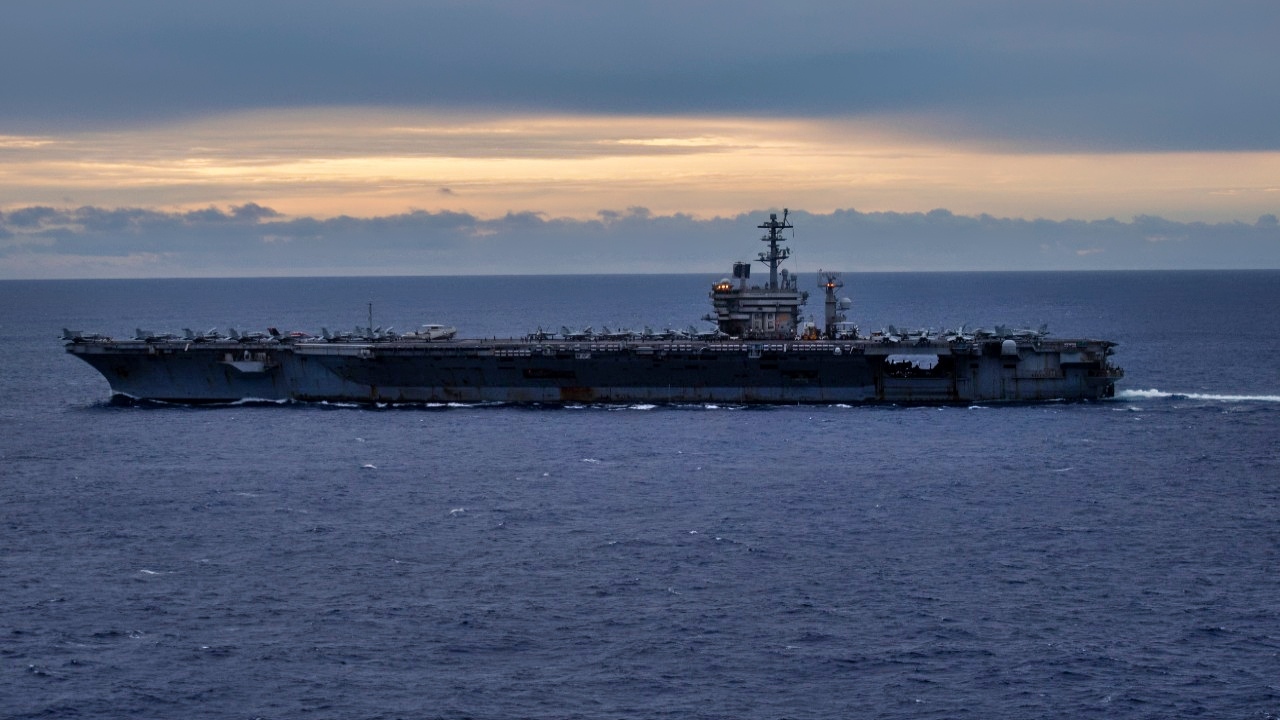Key Points and Summary – The Houthis won’t collapse if Iran’s regime falls. They are rooted in Yemen’s Zaydi politics, possess growing indigenous weapons capacity, and benefit from Iranian smuggling plus increasing Chinese assistance, including guidance systems and supplies funneled via Djibouti to Yemeni ports.
-U.S. strikes in spring 2025 paused after a limited pledge from the Houthis, leaving wider shipping and Israeli targets exposed.

(August 1, 2025) The Arleigh Burke-class guided-missile destroyer USS Wayne E. Meyer (DDG 108) approaches the Nimitz-class aircraft carrier USS Nimitz (CVN 68) for a replenishment-at-sea in the U.S. Central Command area of responsibility. (Official U.S. Navy photo)
-Counting on Tehran’s demise echoes 1990s misreads of North Korea. Even post-Iran, Beijing could back the Houthis to pressure Bab el-Mandeb and Western supply chains.
-Policy implication: treat Yemen as part of the China problem and act accordingly.
China’s Quiet Lifeline to Yemen’s Houthis, Explained
The Houthis are not a creation of the Islamic Republic of Iran; instead, they are a tribal and Zaydi sectarian group that rose up in Yemen due to genuine grievances compounded by the cynicism of the northern Yemeni establishment.
When the Houthis rose in revolt, Iran’s Islamic Revolutionary Guard Corps saw an opportunity. They moved to co-opt the movement and incorporate it into the Islamic Republic’s so-called “Axis of Resistance.”
As Supreme Leader Ali Khamenei’s regime teeters, many U.S. and regional policymakers hope that the Houthis’ grip on Yemen will unravel should the Islamic Republic fall. Superficially, the optimists can point to Syria. When the going got tough in Syria, the Revolutionary Guards abandoned their four-decade partnership with the Assads. To this day, many Assad supporters are bitter that the Iranian regime would not send additional forces to stop the Hay’at Tahrir al-Sham push toward Damascus.
After Houthis attacked U.S. ships in the Red Sea, President Donald Trump ordered U.S. forces to bomb Houthi positions from March 15, 2025, to May 6, 2025, when Trump unilaterally declared a cessation of hostilities with the Houthis so long as they would no longer directly attack U.S. interests.
The Houthis might attack other shipping and launch drones at Israel, but, from the White House perspective, that is a problem for different countries and not a U.S. responsibility to counter.
The North Korea Test Case
There is also an element of wishful thinking in the White House and the intelligence community that with the Axis of Resistance faltering, the Houthis are living on borrowed time. Here, there is a parallel to the Clinton administration’s approach to North Korea.
With Communism collapsing worldwide, President Bill Clinton falsely believed North Korea’s demise was inevitable. His belief, shared by Secretary of State Warren Christopher, colored the U.S. approach toward the 1994 Agreed Framework. Because the U.S. believed that the North Korean regime’s demise was inevitable, it neither pressed too hard nor undertook strategies that would block the regime’s eventual path to nuclear weapons acquisition.
This History
It would be as foolish to pursue a passive policy in the belief that the end of the Islamic Republic will mean the end of the Houthis. First, it misunderstands Yemeni history. The Zaydis have deep roots in Yemen and, indeed, many Yemenis see the Houthis as the newest incarnation of the Imamate, which dominated Yemen from the late sixteenth to mid-nineteenth centuries and then, again, after a brief Ottoman interlude, and then in the early 20th century under Imam Yahya Hamiduddin. Egypt ultimately backed Arab nationalists who overthrew the Imamate in 1962.
The Iran Factor
Indeed, Iran continues to back the Houthis. The Yemeni group maintains an embassy in Tehran. It hosts a small number of Islamic Revolutionary Guard Corps trainers, though in far smaller numbers than the Islamic Republic did in Lebanon and Iraq. The Islamic Revolutionary Guard Corps also continues to smuggle advanced weaponry to the Houthis via dhow from Djibouti, into the poorly monitored Yemeni port of Hudaydah, whose inspections remain more theoretical than practical, and across tribal smuggling routes from Oman through the sparsely populated Yemeni provinces of Mahrah and Hadramawt.
Much of the Houthis’ capability, however, is now via indigenous production. As in Bashar al-Assad’s Syria and Vladimir Putin’s Russia and Emomali Rahmon’s Tajikistan, Iranian authorities have exported not only drones and missiles, but also the capability to make them.
Increasingly, though, the Houthis appear to have acquired not only Iranian weaponry but also advanced missile guidance systems from China. Many of the Iranian anti-ship missiles the Houthis use are clones of Chinese missiles that the Houthis can acquire directly from Chinese suppliers. The counter-Houthi alliance has tracked some of these supplies as they are transferred between ships and offloaded at various ports.
The Chinese presence in Djibouti makes it easier for China to transfer weapons to the Houthis, as Djibouti has reverted to its historical role as a smuggling hub. When missile components, ammunition, and even sodium perchlorate used in solid fuel for missiles get loaded onto much smaller dhows and fishing boats destined for small ports, it can be harder to track and trace.
Chinese Firms Help with Targeting
In April 2025, against the backdrop of the U.S. campaign against the Houthis, evidence emerged that Chinese firms were actively helping the Houthis hunt and attack American ships. While Undersecretary of Defense Elbridge Colby seeks to shift U.S. focus more myopically on China, he imagines the Chinese theater in practice to be limited almost entirely to the Pacific and eastern Indian Ocean basins.
The Chinese have a much broader approach and increasingly see value in disrupting American and European supply chains by blocking ready access to the Bab El-Mandeb strategic chokepoint. Long after Khamenei is dead and the Islamic Republic falls, expect the Chinese to continue to prop up the Houthis as their satrapy on the Arabian Peninsula.
Too often, there is wishful thinking in Washington that when Iranian regime sponsorship ends, the forces of altruism will take hold. That is never the case. Turkey filled the vacuum in Syria and is now trying to establish itself in northern Lebanon. Iran is hoping for a comeback in southern Lebanon, and its ties to Iraqi militias remain strong. In Yemen, it is China that is positioning itself to defend the status quo on the day after.
To believe the United States should not engage in Yemen to focus more on China misreads both Yemen’s reality and China’s strategy. It is negligence that will get Americans killed.
About the Author: Dr. Michael Rubin
Michael Rubin is a senior fellow at the American Enterprise Institute and director of policy analysis at the Middle East Forum. The opinions and views expressed are his own. A former Pentagon official, Dr. Rubin has lived in post-revolution Iran, Yemen, and both pre- and postwar Iraq. He also spent time with the Taliban before 9/11. For more than a decade, he taught classes at sea about the Horn of Africa and Middle East conflicts, culture, and terrorism, to deployed US Navy and Marine units. The views expressed are the author’s own.
More Miliary
The U.S. Navy’s Constellation-Class Crisis Boiled Down to 4 Words
The F-20 Tigershark Light Fighter Boiled Down to 4 Words
China Claims New J-35 Stealth Fighter Is ‘Invisible’
The 5 Greatest U.S. Navy Aircraft Carriers Of All Time
The Navy’s New Ford-Class Aircraft Carriers Can’t Hide All The Problems Anymore











Jim
October 6, 2025 at 1:35 pm
I appreciate the history of Yemen’s politics provided herein.
What does this point to?
That Yemen isn’t anybody’s poodle, they are a self-directed bunch who, yes, have received outside help, but they have their own internal sense of right and wrong.
It’s simple, the Houthis don’t like what’s going on in Gaza and taking actions which reflect such sentiments. The Houthis’s attacks are an irritant to Israel, but not existential in anyway, shape, or form.
The Red Sea shipping? That’s actually a bigger issue as Israel’s Port of Eilat, located at the northern tip of the Gulf of Aqaba has been functionally shutdown and is, for all intents & purposes, bankrupt due to the shutdown (if the missile threat goes away, financing will likely arrive to revive the port’s functionality).
So, where are we? Israel changes its policy towards Gaza (imagine that) and Houthis attacks drop off and Yemeni will go back to being focused on internal tribal politics. Like they have been for centuries.
Until Gaza.
Now, treating Yemen as a satellite of China is making the same mistake as saying Yemen is nothing but an attack dog for Iran (which the author interestingly dispels in his piece).
I agree, the Houthis won’t fall as a result of actions against Iran.
Side note: North Korea agreed to dismantle their nuclear program in exchange for American civilian nuclear technology and construction of civilian nuclear power plants.
But, new information to me, thanks to the author, it turns out, the reason the U. S. under Clinton reneged on the deal was because the Clinton crowd thought North Korea would collapse on its own… there was no need to follow through with the deal. But the anticipated collapse didn’t happen.
And as a result, North Korea, went full speed to develop their nuclear program, both military & civilian… the rest is history.
Yemen and Houthis?
Supporters of Israel (and I include myself, but not this Netanyahu coalition and its policies in Gaza) need to come to the realization Netanyahu’s policy are damaging to Israel.
Netanyahu’s talk of a “super-Sparta” policy is dumb beyond belief… as if being cast out of the Community of Civilized Nations is a good thing (Netanyahu thinks Israel can brazen it out for five to ten years after Gaza is absorbed… I’m not so sure about that).
Wake up, supporters of Israel, Netanyahu and his coalition is driving Israel off the cliff, Thelma & Louise style… not saying anything is being an “enabler” of Israel’s self-inflicted isolation and economic stagnation… not mentioned in the Western Press: many younger Israelis are leaving Israel for more peaceful environments to raise their families.
Greater Israel is a dangerous mirage for supporters of Israel to entertain. When you get there, it’ll be an empty reach of dry sand… no water.